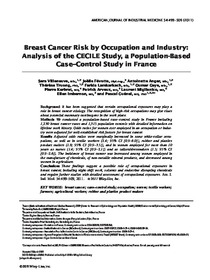Breast cancer risk by occupation and industry: analysis of the CECILE study, a population-based case-control study in France

Villeneuve, Sara ; Févotte, Joëlle ; Anger, Antoinette ; Truong, Thérèse ; Lamkarkach, Farida ; Gaye, Oumar ; Kerbrat, Pierre ; Arveux, Patrick ; Miglianico, Laurent ; Imbernon, Ellen ; Guénel, Pascal
American Journal of Industrial Medicine
2011
54
7
499-509
breast cancer ; case control study ; occupation disease relation ; occupational disease
Occupational diseases
English
Bibliogr.
"BackgroundIt has been suggested that certain occupational exposures may play a role in breast cancer etiology. The recognition of high-risk occupations may give clues about potential mammary carcinogens in the work place.MethodsWe conducted a population-based case-control study in France including 1,230 breast cancer cases and 1,315 population controls with detailed information on lifetime work history. Odds ratios for women ever employed in an occupation or industry were adjusted for well-established risk factors for breast cancer.ResultsAdjusted odds ratios were marginally increased in some white-collar occupations, as well as in textile workers (2.4; 95% CI [0.9-6.0]), rubber and plastics product makers (1.8; 95% CI [0.9-3.5]), and in women employed for more than 10 years as nurses (1.4; 95% CI [0.9-2.1]) and as tailors/dressmakers (1.5; 95% CI [0.9-2.6]). The incidence of breast cancer was increased among women employed in the manufacture of chemicals, of non-metallic mineral products, and decreased among women in agriculture.ConclusionsThese findings suggest a possible role of occupational exposures in breast cancer, including night-shift work, solvents and endocrine disrupting chemicals and require further studies with detailed assessment of occupational exposures."
Digital
The ETUI is co-funded by the European Union. Views and opinions expressed are however those of the author(s) only and do not necessarily reflect those of the European Union or the ETUI.